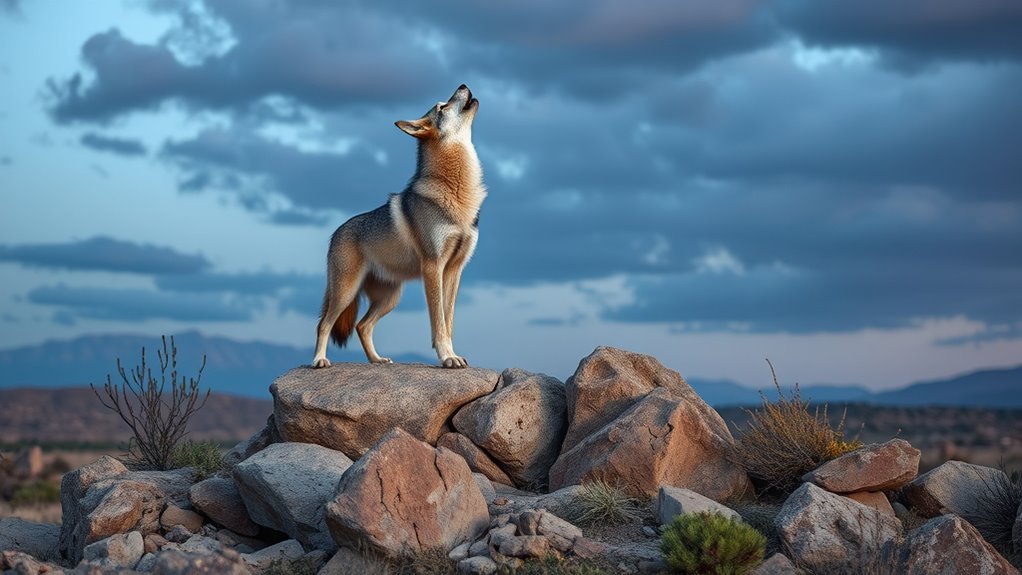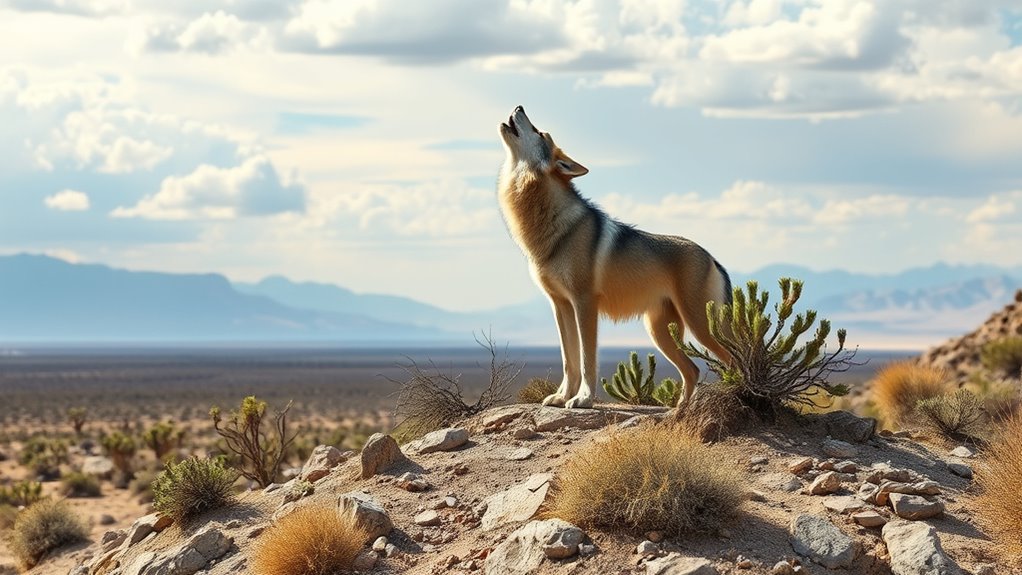The Mexican gray wolf’s recovery is a slow process due to a small, genetically limited population facing habitat and policy challenges. You’ll see efforts like captive releases and habitat expansion trying to boost numbers, but genetics and human conflicts complicate progress. Management debates and land restrictions hamper natural dispersal, making recovery fragile. To learn more about these hurdles and ongoing efforts, keep exploring how conservation strategies are shaping their future.
Key Takeaways
- The Mexican gray wolf population is slowly increasing but remains vulnerable due to genetic bottlenecks and limited habitat expansion.
- Management policies restrict natural dispersal, impeding population growth and genetic diversity recovery.
- Conservation efforts include captive releases and habitat protection, yet conflicts with land use slow progress.
- Genetic health issues, like inbreeding and disease susceptibility, threaten long-term survival despite population gains.
- Enhanced connectivity, policy support, and community engagement are crucial for accelerating recovery efforts.
Tracking the Growing Population and Its Challenges

Tracking the Mexican gray wolf population reveals steady growth, but it also exposes significant hurdles. By early 2025, there are at least 286 wolves in the wild across Arizona and New Mexico, marking nine years of consistent increase. You’ll notice that 60 packs are documented, yet the population remains sparse compared to historic ranges. Limited genetic diversity, stemming from a small founding group, hampers long-term health and resilience. Management policies restrict natural dispersal, preventing wolves from expanding into suitable habitats like the southern Rockies or Grand Canyon. Despite progress, the population stays highly vulnerable due to inbreeding and human-imposed boundaries. These factors threaten the species’ future, highlighting the need for expanded habitat, better genetic exchange, and more supportive policies.
The Impact of Genetic Bottlenecks and Inbreeding

The Mexican gray wolf’s limited genetic pool has profound effects on its survival, as the small founding population—originating from only seven individuals—creates a bottleneck that restricts genetic diversity. This bottleneck reduces genetic variation, making the population more vulnerable to diseases and environmental changes. Inbreeding among closely related wolves leads to health issues like lower reproductive success, nasal tumors, and fused toes, decreasing overall fitness. As genetic diversity declines further, the risk of extinction increases, especially without natural gene flow from northern gray wolves. Despite ongoing recovery efforts, the small gene pool hampers long-term viability. To improve resilience, you need to focus on increasing genetic mixing, either through captive releases or natural dispersal, to break the cycle of inbreeding and boost genetic health. Ensuring proper genetic management is essential for the species’ future adaptability and survival. Addressing genetic bottlenecks through targeted conservation strategies can significantly enhance the wolf’s chances of recovery, but efforts must also consider the importance of regional genetic diversity to prevent further genetic erosion. Incorporating genetic diversity into conservation plans can help mitigate some of the negative effects caused by the bottleneck. Additionally, fostering natural gene flow between isolated populations can be a key component in restoring genetic health and resilience.
Controversies Surrounding Management and Conservation Policies

Controversies surrounding management and conservation policies for the Mexican gray wolf stem from conflicting priorities among stakeholders. Federal and state agencies often prioritize population numbers over genetic health, leading to the removal or killing of genetically valuable wolves, including entire packs. Meanwhile, local communities and some politicians push for delisting protections, citing livestock conflicts and perceived threats, even as recovery efforts advance. Political pressure creates contradictory policies: celebrating population growth while endorsing lethal control measures that undermine long-term success. Management targets are sometimes driven by social tolerance rather than scientific data, fueling disagreements. These conflicting actions hinder habitat expansion, genetic diversity, and overall recovery progress, making it difficult to establish a sustainable, resilient population of Mexican gray wolves.
Habitat Limitations and Opportunities for Expansion

Habitat limitations considerably constrain the Mexican gray wolf’s ability to expand its range, despite ongoing recovery efforts. You’ll find that current recovery areas are politically defined, restricting natural dispersal and preventing wolves from reaching suitable habitats like the southern Rockies and Grand Canyon region. Human land use, ranching, and rural opposition further fragment potential corridors, making movement difficult. While national forests and Native American reservations provide some habitat, these areas are often isolated or limited in size. Opportunities exist to expand into connected, protected landscapes that offer prey and space, but regulatory and land management barriers slow progress. Establishing corridors and expanding protected zones are essential to allow wolves to naturally disperse, increase genetic diversity, and establish new populations. Overcoming habitat restrictions is critical for long-term recovery and resilience.
Strategic Steps Toward a Resilient Future

To build a resilient future for the Mexican gray wolf, strategic actions must focus on science-based management, habitat expansion, and genetic diversity. You should prioritize:
- Increasing the release of captive-bred wolves into protected areas, especially within family packs that support survival and reproduction.
- Expanding habitats beyond current boundaries into regions like the southern Rockies and Grand Canyon to facilitate natural dispersal.
- Promoting genetic exchange by halting removals of valuable wolves and exploring natural gene flow with northern gray wolves.
- Implementing ongoing monitoring and research to better understand population dynamics and adapt management strategies accordingly. Effective habitat restoration can also play a crucial role in providing suitable environments for wolves to thrive. Ensuring public awareness and community engagement can foster support for recovery initiatives. Supporting local communities through conservation education helps create a cooperative approach to species recovery. Incorporating advanced tracking technology can significantly improve monitoring efforts and data collection.
These steps will strengthen the population’s resilience, reduce inbreeding, and improve long-term viability. You must also advocate for policy changes that support recovery, secure funding, and oppose political measures undermining conservation efforts.
Frequently Asked Questions
How Does Climate Change Affect Mexican Gray Wolf Habitats?
Climate change impacts Mexican gray wolf habitats by causing shifts in temperature and precipitation patterns. You might notice droughts reducing prey availability and increasing wildfires, which destroy forests and den sites. Rising temperatures can also alter the ecosystems they depend on, forcing wolves to migrate or face habitat loss. These changes threaten their survival by limiting suitable territory, disrupting reproductive success, and exacerbating existing vulnerabilities caused by limited genetic diversity.
What Role Do Local Communities Play in Wolf Conservation Efforts?
You play a crucial role in wolf conservation by supporting policies that protect their habitats and oppose harmful management actions. Your community’s attitudes influence local policies, funding, and enforcement. Educate others about the importance of wolves for ecosystems, participate in local conservation programs, and advocate for coexistence strategies. Your involvement can help reduce conflicts, change perceptions, and guarantee long-term survival of the Mexican gray wolf in its natural range.
Are There Plans to Reintroduce Wolves Into New Regions Beyond Current Areas?
Yes, there are plans to reintroduce wolves into new regions beyond current areas. You can support efforts to expand habitats, especially in the southern Rockies and Grand Canyon, by advocating for policy changes and habitat protection. Increasing releases of captive-bred wolves in suitable, unoccupied areas will help establish new populations. Your involvement can also influence decision-makers to prioritize natural dispersal and habitat connectivity, vital for long-term recovery.
How Is Genetic Diversity Monitored and Managed Among the Wolf Population?
You monitor genetic diversity through DNA analysis of wolf samples, tracking gene variation across populations. To manage it, you release captive-bred wolves with diverse genetics, avoiding inbreeding issues. While natural gene flow from northern gray wolves could help, restrictions limit dispersal. Balancing conservation with political challenges, you focus on increasing genetic variation by maintaining family packs and preventing the removal of genetically valuable wolves to make certain of long-term survival.
What Funding Sources Support Long-Term Recovery and Protection Initiatives?
You can find funding for Mexican gray wolf recovery through federal agencies like the U.S. Fish and Wildlife Service and the U.S. Forest Service, which allocate money for conservation and research. Additionally, private foundations and nonprofit organizations contribute grants and donations to support habitat protection, captive breeding programs, and public education. Sometimes, state governments also provide funding to enhance local conservation efforts. These combined sources help sustain long-term recovery initiatives.
Conclusion
You’re witnessing a battle for survival that’s more intense than any Hollywood epic. The Mexican gray wolf’s slow comeback may seem fragile, but every step forward is a testament to resilience. With continued effort and smarter strategies, you can help turn the tide and guarantee these majestic creatures roar back from the brink. The road to recovery is long, but your support can make the difference between extinction and a thriving future.







